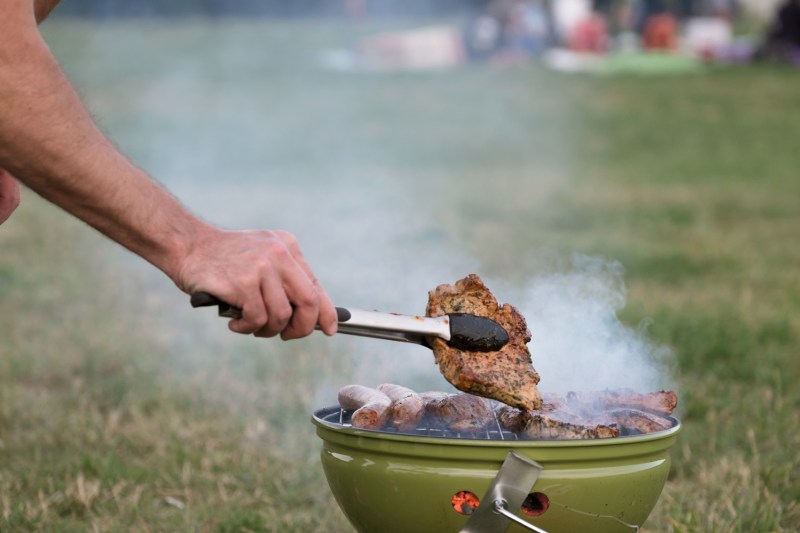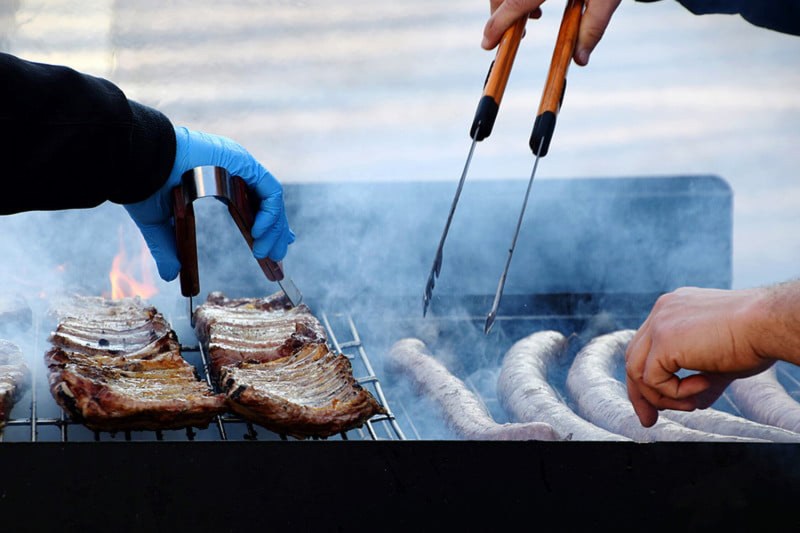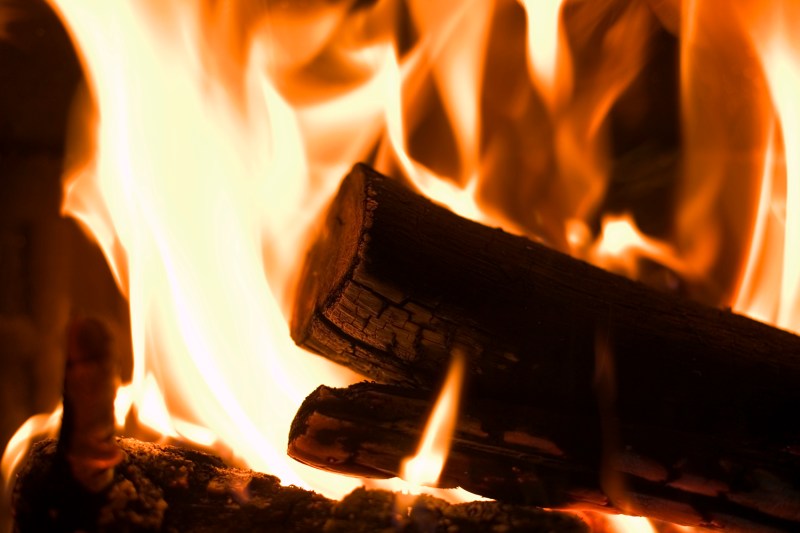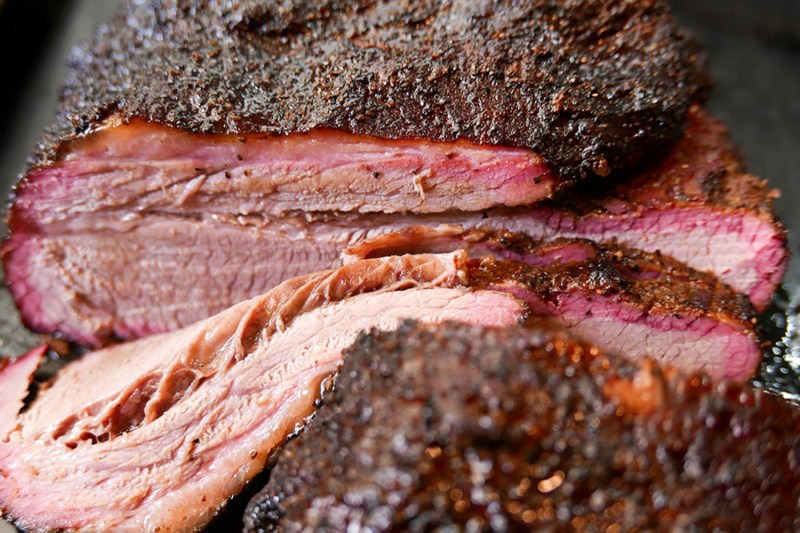
Smoking, which began as a traditional method of food preservation, has now become a timeless art form that has evolved with the help of technological advances and years of culinary trial and error. Despite the ubiquity of modern ways of cooking, the idea of savoring the flavors of smoked meat has kept the tradition alive, further elevating this age-old practice to a level of mastery on par with any other cooking endeavor.
To kick-start your culinary journey this year, we’re providing you with a comprehensive guide to help you navigate the roundabouts of how to smoke meat, a classic cooking technique. So, what are you waiting for? Prepare your smokers and let’s get smokin.’

Types of smokers
Before you get started, you first need to learn the difference between the various types of smokers. Here’s a rundown of each kind.
Electric smokers
These use electricity to heat up a rod (or similar heating element), which then causes the wood to smoke. These are the easiest in terms of heat control since all you have to do is turn a dial to adjust the temperature. They also tend to be the most expensive, and they impart the least amount of smoked flavor compared to the other options.
Propane smokers
Propane smokers work almost exactly like electric smokers, but use a gas-fueled flame instead of a heating element to make the wood pellets smolder. These are pretty simple and might be a better choice for people in areas where electricity is expensive or scarce.
Charcoal smokers
These are a favorite among barbecue masters, who believe that charcoal imbues more flavor compared to propane or electric ones. Charcoal smokers tend to be cheaper, but you also have to buy charcoal every time you want to smoke. Charcoal also requires you to start and maintain a fire without the help of modern technology.
Wood smokers
Wood smokers are definitely the way to go for the purest flavor, but they require the most attention and care out of all the options because they’re harder to keep at a constant temperature. For this reason, we only recommend wood smokers after you’ve learned the basics.
Pellet smokers
These are similar to wood smokers, but the wood has been condensed into a convenient pellet form (hence the name). This makes them much easier to use. Instead of splitting firewood, stacking it, and babysitting the flame, you simply load the pellets into an oven-like compartment. The only downside? Like their electric brethren, pellet smokers tend to be expensive.

Best meats to smoke
When hunting for the right chunk of meat, try to pick something that will benefit from the slow-cooking process. Don’t shy away from cuts with lots of connective tissue and fat, known as “marbling.” A generous marble will make the finished product more succulent and delicious.
Beef brisket is a go-to, and you can never go wrong with ribs. Pork shoulder is another meat that lends itself to smoking. If you want to smoke a steak, the bigger the cut, the better. You might also turn to your local butcher shop for some lesser-known cuts like tri-tip and chuck eye, just to see what happens. Who knows, you may fall in love with a new cut of meat.
After you have your cut of steak, pork, or chicken, you’ll need some wood.

Wood for smoking meat
Not all wood is created equal, so you have lots of choices when it comes to the type of wood to smoke your meat. Here’s an exhaustive list.
- Alder has a light and naturally sweet flavor, which makes it great for pairing with fish, poultry, and any white meat.
- Applewood has a fruity and sweet smoke that pairs wonderfully with pork, fish, and poultry.
- Hickory has a strong and distinct flavor that’s ideal for red meat, especially ribs.
- Pecan gives your meat somewhat of a fruity flavor and burns cooler than most other barbecue woods. It’s similar to hickory and is best used on large cuts like brisket and pork roast, but can also be used to complement chops, fish, and poultry.
- Maple has a sweet and delicate taste and tends to darken whatever meat you’re smoking. It goes well with alder, oak, or applewood, and is typically used for poultry and ham.
- Mesquite is undoubtedly the most pungent wood you can smoke, which means it can easily overpower your meat if used improperly. Avoid using mesquite with larger cuts that require longer cooking times. You can also use it with a mix of other woods.
- Oak, on the other hand, is great for big cuts of meat that take a long time to cook. It has a subtle flavor that will emerge further the longer the meat is in the smoker.
- Cherrywood is best suited for red meat and pork; it also pairs well with alder, hickory, and oak.

The importance of brining
Brining your meat keeps it from drying out during the smoking process. It’s all about the science of brining — the salt in the brine makes the proteins in the meat more water-absorbent. When sodium and chloride ions get into the meat tissue, their electrical charges mess with the proteins (especially myosin), so they can hold on to moisture more effectively and lose less of it during the cooking process. For optimal moisture retention, soak your meat in a brine for 10 to 12 hours before smoking.
In its most basic form, brine is nothing more than salty water; however, it benefits from the addition of herbs and spices. To make a good base, add three tablespoons of salt to one quart of water, then throw in whatever else you prefer. Brining is a bit of a double-edged sword: It helps the meat retain moisture but also makes it saltier. Some chefs use sugar and molasses to combat the salty flavor.

Keep it low and slow
Low and slow is the key to good meat. Keep your temperature between 212 degrees Fahrenheit and 230 degrees Fahrenheit for the best results. These lower temperatures generally won’t cause the meat’s cell walls to burst, which helps make the meat more succulent and allows it to retain nutrients.
Cooking at low temperatures also makes it possible for tough collagen in the connective tissue of meat to be hydrolyzed into gelatin without overheating the proteins. In other words, smoking it low and slow lets all the tough tissue dissolve into the meat while simultaneously giving the smoke time to absorb.

How does smoking preserve the meat?
As mentioned above, smoking meat is an age-old technique that not only adds a distinctive flavor but also helps preserve it. Here’s a breakdown of how smoking works to extend the shelf life of meat.
Drying
The smoking process itself involves exposing the meat to smoke at a controlled temperature. This heat, along with the airflow within the smoker, draws out moisture from the meat’s surface. This drying process creates an environment less hospitable to bacteria, which thrive in moist conditions.
Antimicrobial and antifungal properties
Smoke from burning wood contains various chemicals that possess antimicrobial and antifungal properties. These compounds, such as phenols, creosols, and organic acids, create a somewhat hostile environment on the surface of the meat, hindering the growth of bacteria and mold that can spoil the meat.
Antioxidant effect
Smoke also has antioxidant properties, which help slow down the oxidation of fats in the meat. This process, known as rancidification, can cause the meat to develop an unpleasant odor and flavor. By slowing down oxidation, smoking helps maintain the quality and taste of the meat for a longer period.
It’s important to note that while smoking extends the shelf life of meat, it’s not a foolproof preservation method on its own. Traditionally, smoking is often combined with other preservation techniques like salting and curing for a more significant and longer-lasting effect.



